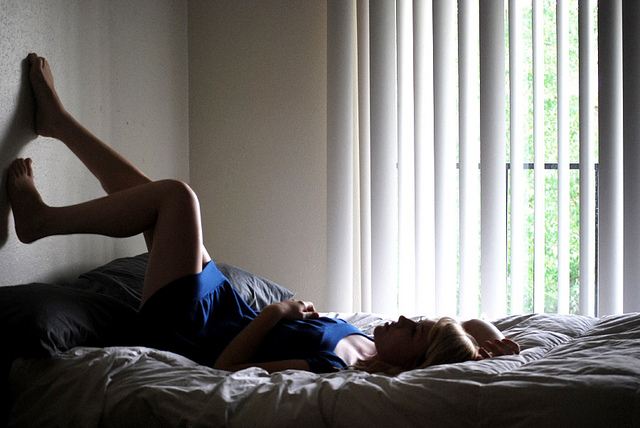One of my new absolute favorite places to practice mindfulness is in bed.
For those of you out there who are good sleepers, who just crawl into bed and fall asleep for eight to 10 hours, and wake up the next morning ready to rock and roll, perhaps the fact that lying in bed is a nice time of the day won’t be shocking news for you.
But for many people, like myself, who find the process of falling asleep elusive at best and downright frustrating at worse, even the notion that the bed could be a place to practice a type of peaceful mindfulness can come as a revelation.
The busy brain going round and round, the fear that tomorrow will be ruined because of lack of sleep, the annoyningness of not being able to control such an important bodily activity such as sleep—for us insomniacs this is what the experience of lying in our own beds can be all about.
But another part of lying in bed not being asleep, I’m learning, is that there are all of these pleasurable experiences that are happening that have nothing to do with being able to sleep or not sleep.
This is what’s so amazing about mindfulness practice.
Beyond the thoughts in the mind there are so many sensory experiences, that once we learn how to tune in, they can bring us immense pleasure.
And lying in a bed has many opportunities for these sensory experiences.
1. Gratitude
Not everyone has a bed. Not everyone has a blanket and a pillow and a warm place to lie down every night. Really, each of us who gets to sleep on a specially crafted mattress designed for the most comfort possible, is incredibly lucky. Can’t sleep? Not a big deal because we are warm and lying on a comfortable surface with a cozy blanket and multiple pillows.
With this gratitude at the front of our awareness we can allow ourselves to let the mind soften and quiet and let our consciousness fill with the knowledge that we’re incredibly fortunate to be lying in a bed at all.
2. Breath
Maybe we aren’t sleeping but we’re definitely breathing. And isn’t that a miracle? Focusing on the breath is one of the best ways to move our attention away from our thoughts. And when we give focused attention to the breath, we can see how textured, impermanent and interesting it is. Not being able to sleep is never a waste of time if instead of sleeping we’re strengthening the muscle of mindfulness by noticing the breath.
3. Contact
What I mean here is contact against the mattress—the body’s weight against the mattress and the blankets and the pillows. This is my favorite part of being in bed lately. Just feeling the coziness of being held by a bed and being tucked into blankets and having a pillow under my head. When we give all of our attention to this experience, we can see how deluxe and luxurious being in a bed is.
4. Being With Whatever is Happening
Maybe we can’t sleep because there are feelings that need to be felt. This is also a good, productive use of time. Yes, we might feel drained, depleted and worn-out the next day but we can know it was for a good reason. This is different than worrying or spinning a situation through our minds. This is just showing up and saying to ourselves “I am here to support you as long as it takes.” This is a type of mindfulness, too—not shoving our feelings down but being mindful with whatever is rising up.
5. Dream States
There is being awake and there is being asleep and then there is something in-between. This can be a wonderful place. A drifty, dreamy half-conscious, half not so-conscious kind of state. And it is neat to experience. Sometimes, instead of deep sleep, I drift around in this half-zone for hours. Why not? It’s a state of reality, too.
We live in a sleep-deprived culture that uses multiple forms of caffeine and drugs to keep us fueled during our busy lives.
But what I’m suggesting here is, instead of forcing our sleep habits to be different, we just be with whatever is occurring.
Especially, in bed.
Relephant:
20 Ingredients for Quality Sleep, Every Night.
Author: Ruth Lera
Editor: Catherine Monkman
Photo: Aimee Heart/Flickr









Read 3 comments and reply